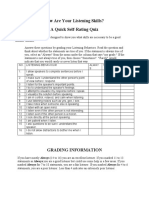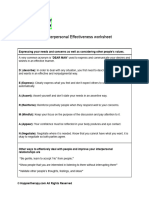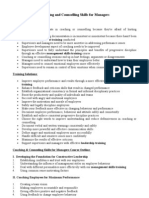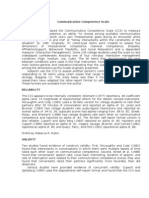5.2 Task Relationship Questionnaire PDF
5.2 Task Relationship Questionnaire PDF
Uploaded by
Mirela PolicCopyright:
Available Formats
5.2 Task Relationship Questionnaire PDF
5.2 Task Relationship Questionnaire PDF
Uploaded by
Mirela PolicOriginal Title
Copyright
Available Formats
Share this document
Did you find this document useful?
Is this content inappropriate?
Copyright:
Available Formats
5.2 Task Relationship Questionnaire PDF
5.2 Task Relationship Questionnaire PDF
Uploaded by
Mirela PolicCopyright:
Available Formats
Chapter 5 Attending to Tasks and Relationships 117
5.2 TASK AND RELATIONSHIP QUESTIONNAIRE
Purpose
1. To identify how much you emphasize task and relationship behaviors in your life
2. To explore how your task behavior is related to your relationship behavior
Directions
For each item below, indicate on the scale the extent to which you engage in the described behavior. Move
APPLICATION
through the items quickly. Do not try to categorize yourself in one area or another.
Statements Never Rarely Sometimes Often Always
1. Make a “to do” list of the things that need to be done. 1 2 3 4 5
2. Try to make the work fun for others. 1 2 3 4 5
3. Urge others to concentrate on the work at hand. 1 2 3 4 5
4. Show concern for the personal well-being of others. 1 2 3 4 5
5. Set timelines for when the job needs to be done. 1 2 3 4 5
6. Help group members get along. 1 2 3 4 5
7. Keep a checklist of what has been accomplished. 1 2 3 4 5
8. Listen to the special needs of each group member. 1 2 3 4 5
9. Stress to others the rules and requirements for the project. 1 2 3 4 5
10. Spend time exploring other people’s ideas for the project. 1 2 3 4 5
11. Pay close attention to project deadlines. 1 2 3 4 5
12. Act friendly toward other group members. 1 2 3 4 5
13. Clarify each group member’s job responsibilities. 1 2 3 4 5
14. Express support for other group members’ ideas. 1 2 3 4 5
15. Emphasize performance standards for the group. 1 2 3 4 5
16. Talk with other group members about their personal concerns. 1 2 3 4 5
17. Keep other group members focused on goals. 1 2 3 4 5
18. Emphasize everyone’s unique contributions to the group. 1 2 3 4 5
19. Follow rules and regulations closely. 1 2 3 4 5
20. Express positive feelings toward others in the group. 1 2 3 4 5
118 INTRODUCTION TO LEADERSHIP
5.2 TASK AND RELATIONSHIP QUESTIONNAIRE
(continued)
Scoring
1. Sum scores for the odd-numbered statements (task score).
2. Sum scores for the even-numbered statements (relationship score).
Total Scores
APPLICATION
Task score: ________________________
Relationship score: _______________
Scoring Interpretation
This questionnaire is designed to measure your task-oriented and relationship-oriented leadership behavior. By
comparing your scores, you can determine which style is more dominant in your own style of leadership. If your
task score is higher than your relationship score, you tend to give more attention to goal accomplishment and
somewhat less attention to people-related matters. If your relationship score is higher than your task score, your
primary concern tends to be dealing with people, and your secondary concern is directed more toward tasks.
If your scores are very similar to each other, it suggests that your leadership is balanced and includes an equal
amount of both behaviors.
If your score is 45–50, you are in the very high range.
If your score is 40–44, you are in the high range.
If your score is 35–39, you are in the moderately high range.
If your score is 30–34, you are in the moderately low range.
If your score is 25–29, you are in the low range.
If your score is 10–24, you are in the very low range.
Building Your Leadership Profile
If you have the interactive eBook version of this text, log in to access the Leadership Profile Tool. After complet-
ing this chapter’s questionnaire, you will receive individualized feedback and practical suggestions for further
strengthening your leadership based on your responses in this questionnaire.
Visit edge.sagepub.com/northouseintro3e for a downloadable version of this questionnaire.
You might also like
- Leadership Style TestDocument5 pagesLeadership Style TestnixeejpNo ratings yet
- Attribution Style QuestionnaireDocument7 pagesAttribution Style QuestionnaireLuka NjezicNo ratings yet
- Ciccarelli PrefaceDocument23 pagesCiccarelli PrefaceSarath V Winterina Mariposan50% (2)
- Standard Stress Assessment Questionnaire TemplateDocument1 pageStandard Stress Assessment Questionnaire TemplateErica HugNo ratings yet
- 9 Type A and B Personality TestDocument2 pages9 Type A and B Personality Testapi-616790481No ratings yet
- ETC Webinar Communication Styles AssessmentDocument5 pagesETC Webinar Communication Styles AssessmentCorina IcaNo ratings yet
- Summary Book Communicating at Work Communication Chapters 1 5 LecturesDocument18 pagesSummary Book Communicating at Work Communication Chapters 1 5 LecturesRayhanNo ratings yet
- The Power of Positive AttitudeDocument3 pagesThe Power of Positive AttitudeSiyaa Singh100% (1)
- Questionnaire On Employee EmpowermentDocument7 pagesQuestionnaire On Employee EmpowermenteswariNo ratings yet
- The 1 HABIT To Practice FIRST THING in The MORNING Gaur Gopal Das Top 10 Rules CompressedDocument3 pagesThe 1 HABIT To Practice FIRST THING in The MORNING Gaur Gopal Das Top 10 Rules CompressedAnirudhMagniNo ratings yet
- The 4 Types of Ineffective ApologiesDocument5 pagesThe 4 Types of Ineffective ApologiesPushpendra Kumar SinghNo ratings yet
- 3 Activities For Adults To Practice Modeling SELDocument10 pages3 Activities For Adults To Practice Modeling SELDavid Garcia PerezNo ratings yet
- 4 Causes of Family ConflictDocument1 page4 Causes of Family ConflictMa. Sharese Terania100% (1)
- Words and Phrases To Avoid in A Difficult ConversationDocument5 pagesWords and Phrases To Avoid in A Difficult ConversationvvvNo ratings yet
- Overcome OverwhelmDocument2 pagesOvercome OverwhelmZerneus CharlesNo ratings yet
- Personal Development Plan TemplateDocument2 pagesPersonal Development Plan TemplateAmanpreet singhNo ratings yet
- Open-Ended and Closed QuestionsDocument2 pagesOpen-Ended and Closed QuestionsKareem AbdoNo ratings yet
- Whats My Coaching Style Sample Online ReportDocument11 pagesWhats My Coaching Style Sample Online Reportmc4bballNo ratings yet
- Leadership and Coaching Styles QuestionnaireDocument2 pagesLeadership and Coaching Styles QuestionnaireLeocel Alensiaga0% (1)
- BuildlovemapsworksheetDocument1 pageBuildlovemapsworksheetapi-488114435No ratings yet
- Coping With StressDocument22 pagesCoping With StressJinu NamboodiriNo ratings yet
- Friendships WorksheetDocument5 pagesFriendships WorksheetGavin ElderNo ratings yet
- Lesson Plan Managing ImpulsivityDocument1 pageLesson Plan Managing Impulsivityapi-379690668No ratings yet
- Games and Exercises For Couples TherapyDocument4 pagesGames and Exercises For Couples TherapyScribdTranslationsNo ratings yet
- Smart Goals 1Document1 pageSmart Goals 1api-340502828No ratings yet
- Goal Setting For StudentsDocument26 pagesGoal Setting For StudentsAmruth PnsNo ratings yet
- TipSheet SelfAwarenessDocument3 pagesTipSheet SelfAwarenesscatch00000100% (3)
- My Leadership StyleDocument6 pagesMy Leadership Styleapi-270957642No ratings yet
- Vision and Mission MakingDocument3 pagesVision and Mission MakingNiwled UyNo ratings yet
- The Managerial Grid AnalysisDocument8 pagesThe Managerial Grid AnalysisdpegasusNo ratings yet
- Managerial Style QuestionnaireDocument4 pagesManagerial Style QuestionnairePrabhat GargNo ratings yet
- Exercise Our+Shared+VisionDocument4 pagesExercise Our+Shared+VisionNur Cahya UtamaNo ratings yet
- How Are Your Listening SkillsDocument2 pagesHow Are Your Listening SkillsCheryl Lynn CharlesNo ratings yet
- DBT Interpersonal Effectiveness WorksheetDocument2 pagesDBT Interpersonal Effectiveness WorksheetsciptNo ratings yet
- Big-Five Personality Inventory: Response OptionsDocument5 pagesBig-Five Personality Inventory: Response OptionsArpit Sachdeva100% (1)
- Self Assessment Exercises 2021Document14 pagesSelf Assessment Exercises 2021Beloved1234No ratings yet
- Bs 621: Human Resource Management: Topic 5: Performance EvaluationDocument42 pagesBs 621: Human Resource Management: Topic 5: Performance EvaluationMaster KihimbwaNo ratings yet
- Teaching - Style - QuestionnaireDocument4 pagesTeaching - Style - QuestionnaireClaChristina100% (1)
- Cluster B Personality Disorder TestDocument3 pagesCluster B Personality Disorder Testattiyawakil0No ratings yet
- Five Conversations FrameworkDocument4 pagesFive Conversations FrameworkscorpionrockNo ratings yet
- Emotional Intelligence AssessmentDocument3 pagesEmotional Intelligence AssessmentlahayilNo ratings yet
- Assertiveness ProjectDocument4 pagesAssertiveness ProjectNitin SaxenaNo ratings yet
- Listening Skills Self-Assessment: Put An X in The Appropriate ColumnDocument4 pagesListening Skills Self-Assessment: Put An X in The Appropriate ColumnsushilNo ratings yet
- Types of ConflictDocument40 pagesTypes of Conflictzzeh100% (1)
- Job Satisfaction Questionnaire ExampleDocument3 pagesJob Satisfaction Questionnaire Exampleabba yakubuNo ratings yet
- 4 Types of ListeningDocument15 pages4 Types of Listeningnur azreenNo ratings yet
- Belbin's Team Roles - Lec 4Document5 pagesBelbin's Team Roles - Lec 4Tharushi DiyanaNo ratings yet
- Day 3 PPT - What Is LeadershipDocument15 pagesDay 3 PPT - What Is LeadershipJivitesh SharmaNo ratings yet
- Emotional Intelligence - Session 1 PDFDocument4 pagesEmotional Intelligence - Session 1 PDFAnderson CastroNo ratings yet
- Mindfulness ActivitiesDocument6 pagesMindfulness Activitiesapi-339694564No ratings yet
- Leadership SurveyDocument3 pagesLeadership Surveyaakash1119No ratings yet
- Self Efficacy ScaleDocument2 pagesSelf Efficacy ScaleShruti ShrivastavaNo ratings yet
- SS-ST Augustine-3-12-11-Materialism & GreedDocument26 pagesSS-ST Augustine-3-12-11-Materialism & GreedHannah Cardel PoralNo ratings yet
- Humanbe, Self - Assessment Motivation SelfDocument5 pagesHumanbe, Self - Assessment Motivation SelfHans LeeNo ratings yet
- Mindset Questionnaire, TECDocument6 pagesMindset Questionnaire, TECRiya RaneNo ratings yet
- Needs and Imporatnce of PersonalityDocument3 pagesNeeds and Imporatnce of Personalityqadiradnan7177No ratings yet
- Rosenberg Self-Esteem ScaleDocument2 pagesRosenberg Self-Esteem ScaleEj TolentinoNo ratings yet
- Counseling Skills For ManagersDocument2 pagesCounseling Skills For ManagersNeha AhujaNo ratings yet
- Leadership Style QuizDocument2 pagesLeadership Style QuizgilhafNo ratings yet
- Leadership Behavior Questionnaire: Leadership Theory and PracticeDocument2 pagesLeadership Behavior Questionnaire: Leadership Theory and Practiceyyyy100% (1)
- Leadership Theory and Practice, Northouse, Peter, Sage, 2012, PP 88-89Document3 pagesLeadership Theory and Practice, Northouse, Peter, Sage, 2012, PP 88-89KEVIN BROWNENo ratings yet
- Participant Leadership Competency QuestionnaireDocument4 pagesParticipant Leadership Competency QuestionnaireMirela PolicNo ratings yet
- GRUNIGDocument20 pagesGRUNIGMirela PolicNo ratings yet
- Gender Stereotypes and Self-Perceptions Among College StudentsDocument12 pagesGender Stereotypes and Self-Perceptions Among College StudentsMirela PolicNo ratings yet
- Communicative CompetenceDocument5 pagesCommunicative CompetenceAnita AroraNo ratings yet
- Self-Branding On Social Media: An Analysis of Style Bloggers On InstagramDocument9 pagesSelf-Branding On Social Media: An Analysis of Style Bloggers On InstagramMirela PolicNo ratings yet
- An Inside Out Approach To Integrated Marketing CommunicationDocument39 pagesAn Inside Out Approach To Integrated Marketing CommunicationMirela Polic100% (1)
- Understanding The Dimensions of Trust in Public Relations and TheDocument260 pagesUnderstanding The Dimensions of Trust in Public Relations and TheMirela PolicNo ratings yet
- The Empathetic SchoolDocument9 pagesThe Empathetic SchoolLisbeth RamosOrtega100% (1)
- Homeroom Guidance Module 2Document6 pagesHomeroom Guidance Module 2Jovelyn92% (38)
- Whole Document Midterm PerdevDocument14 pagesWhole Document Midterm PerdevJoy TignoNo ratings yet
- Imitating Freedom, A Buddhist Refutation of ActualismDocument15 pagesImitating Freedom, A Buddhist Refutation of Actualism5f54ftfNo ratings yet
- Rethinking Drive TheoryDocument18 pagesRethinking Drive Theoryმარი შეყილაძეNo ratings yet
- Models of Health and WellnessDocument5 pagesModels of Health and WellnessGlory Glory100% (1)
- The Spine and The Human Energy FieldDocument12 pagesThe Spine and The Human Energy Fieldsatyabrata muduliNo ratings yet
- The Mind and MatterDocument158 pagesThe Mind and MatterStacey T Pollock100% (2)
- Homeroom Guidance: Quarter 3 - Module 8: The Power (Positivity, Optimism and Resiliency) To CopeDocument13 pagesHomeroom Guidance: Quarter 3 - Module 8: The Power (Positivity, Optimism and Resiliency) To CopeRoela Marie Albania100% (1)
- Brief Summary EthicsDocument22 pagesBrief Summary EthicsHeart AbagNo ratings yet
- The Seven Habits of Highly Effective People: Restoring The Character EthicDocument48 pagesThe Seven Habits of Highly Effective People: Restoring The Character EthicIrina JhaNo ratings yet
- 2016 - Why Improving and Assessing Executive Functions - Diamond PDFDocument36 pages2016 - Why Improving and Assessing Executive Functions - Diamond PDFMADDAMNo ratings yet
- Philosophical Foundation of EducationDocument21 pagesPhilosophical Foundation of EducationSAMANTHA L. POLICARPIONo ratings yet
- Philosophical Perspective of The SelfDocument12 pagesPhilosophical Perspective of The Selfnicolas taylorNo ratings yet
- Emotional Intelligence and ResilienceDocument6 pagesEmotional Intelligence and ResilienceBogdan HadaragNo ratings yet
- UTS Lesson 3 Perspective of PsychologyDocument5 pagesUTS Lesson 3 Perspective of PsychologyRAYMUND QUIGTARNo ratings yet
- The Deora Mindfulness ProgrammeDocument56 pagesThe Deora Mindfulness ProgrammeJez C100% (1)
- Viktor Frankl: Dr. C. George Boeree Shippensburg UniversityDocument12 pagesViktor Frankl: Dr. C. George Boeree Shippensburg UniversityMalyasree BasuNo ratings yet
- Report in Project Team BuildingDocument43 pagesReport in Project Team BuildingHarold TaylorNo ratings yet
- Positive Affect and Complex Dynamics of Human FlourishingDocument9 pagesPositive Affect and Complex Dynamics of Human FlourishingAnya Romanov100% (1)
- Slavin - Becoming An IndividualDocument18 pagesSlavin - Becoming An Individualmircea3006No ratings yet
- 7 Steps To Maximize Your Full Potential NDocument20 pages7 Steps To Maximize Your Full Potential Nkingscorp100% (1)
- Bsed 1 - Understanding The Self Week 3-4Document2 pagesBsed 1 - Understanding The Self Week 3-4Laarni ToleteNo ratings yet
- Pajares y Valiente 2002 Student S Self Efficacy in Their Self Regulated Learning StrategiesDocument11 pagesPajares y Valiente 2002 Student S Self Efficacy in Their Self Regulated Learning StrategiesJuan Hernández García100% (1)
- Group Process PDFDocument52 pagesGroup Process PDFpreciousrain07No ratings yet
- Unit Test in PERDEVDocument2 pagesUnit Test in PERDEVGladys CamposNo ratings yet
- Mercury in PiscesDocument2 pagesMercury in PiscesMariana DiaconuNo ratings yet
- Lawrence Kohlberg's Moral DevelopmentDocument19 pagesLawrence Kohlberg's Moral DevelopmentJeru Gaiser100% (1)
































































































